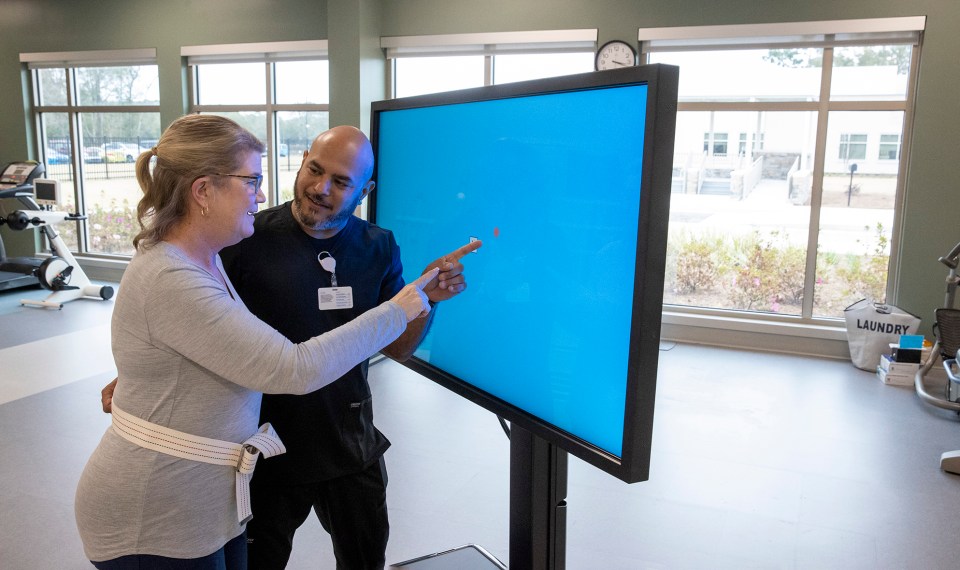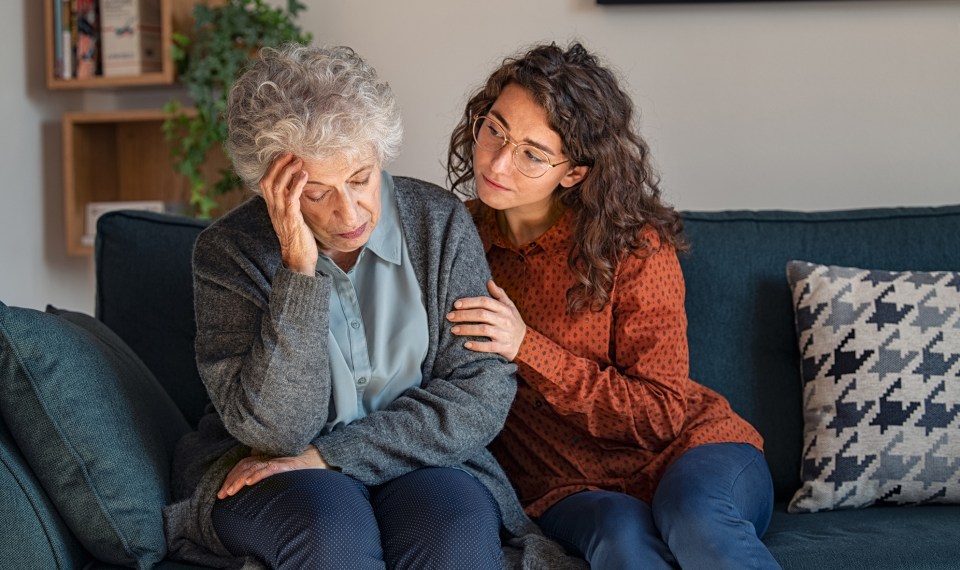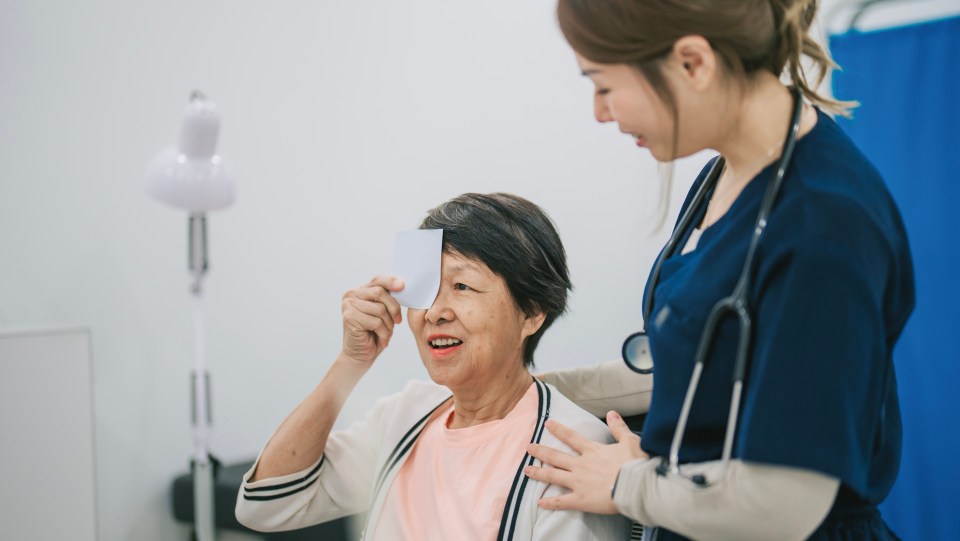A stroke is a complex condition that can affect you both physically and mentally.
While treatment of a stroke depends on the severity and the side-effects you experience, physical therapy for stroke will likely be part of your recovery and, if possible, should start as soon as your condition stabilizes.
“The early days are really critical,” said Theresa Beckmann, a physical therapist at Encompass Health Rehabilitation Hospital of East Valley in Arizona. Beckmann is a Neurological Clinical Specialist, who specializes in physical therapy for stroke and other neurological conditions. “Every day you don’t do therapy is an opportunity missed. It’s not just about recovery. It’s also about maintaining what you haven’t lost.”
A stroke occurs when there is a sudden disruption or loss of blood flow to the brain. This can cause damage to the area of the brain that controls both voluntary and involuntary movement. A physical therapist can help you reestablish some of those brain-muscle connections through individualized therapy and exercise plans.
What is Physical Therapy?
According to the American Physical Therapy Association, physical therapists are “movement experts who improve quality of life through prescribed exercise, hands-on care and patient education.”
There are several types of physical therapy from geriatrics to pediatrics and sports to pain management.
When it comes to physical therapy for stroke recovery, you will want a physical therapist who has experience in treating neurological disorders. While not available at all hospitals, a Neurological Clinical Specialist, or NCS, is a licensed physical therapist who has had more than 2,000 hours of clinical practice working with patients with disorders of the nervous system, such as stroke.
How Does Physical Therapy After Stroke Address Common Side?
A stroke can come with a variety of side effects and symptoms that can affect you both physically and mentally. Some of the more common physical side effects of a stroke that PT can address include:
- Lack of muscle control on one side of the body, known as hemiparesis, which occurs on the opposite side of your body from where your stoke occurred.
- Rigidness or tight muscles, also known as spasticity
- Flaccidity, or low muscle tone
- Problems with balance and coordination
- Difficulty performing certain movements or gestures, also known as apraxia
While you may think physical therapy can only address your physical needs and deficits, Beckmann said when it comes to PT for stroke recovery, cognition also could be addressed.
“It’s a common misconception that only occupational and speech therapists address cognition,” she said. “We have to include cognition in the treatment plan (for physical therapy), or it’s not going to be successful. We need to understand where to clarify and when to simplify depending on how the brain is processing. Do we need to simplify it, or do we need to turn it up? We want our patients to be able to meet the demands of the real world.”
Technologies and Techniques That Could be Used
There are a variety of technologies and techniques your physical therapist might incorporate into your treatment plan. They could include:
Functional electrical stimulation: This is commonly used to treat weaknesses or stiffness your stroke may have caused in parts of your body. In electrical stimulation therapy, non-invasive electrodes are placed on your skin of the affected areas. These electrodes send mild electrical pulses to “turn the muscles on,” Beckmann said. She added that this therapy is best paired with other functional activities.
The Bioness L300 provides electrical stimulation to the thigh or upper and lower leg and can be paired with other exercises, such as walking and cycling.
Weight bearing: Weight bearing is considered a treatment option. This technique uses your body weight to support yourself, which can be challenging after a stroke. Advanced technologies, such as the LiteGate, a static body-weight support system commonly used on a treadmill, could be used to help you gradually bear weight safely. Another technology often used is the Vector, Beckmann added. This harness support system helps you bear weight and practice walking without the fear of falling.
In addition to advanced technologies, Beckmann said your physical therapist will also be looking at low-tech options. “We can use walkers, for example, to help arms bear weight. We want to make sure we are looking for ways to include an affected arm into what we are doing as well.” Beckmann said. “We’re giving the brain as much input as possible to get the body and brain opportunities to reconnect.”
Other low-tech options include bracing the ankle to help support the body while your PT works on the hip, or pushing a resistance sled much like those used in football practice. “We look for ways to build intensity or increase how many times we can repeat an activity in a session because that just creates more opportunities for the brain to relearn what it has lost.” Beckmann said.
Balance and coordination exercises: Even if you are able to activate your muscles, you might have difficulties doing it smoothly. For this reason, balance and coordination exercises and techniques should be part of your physical therapy treatment plan for stroke. This is something you could do to music and incorporate dance, “especially if that’s something the patient likes,” Beckmann said. A metronome also could be used with your PT having you tap your foot in time with it.
A more advanced technology for coordination is the Bioness Integrated Therapy System (BITS). It uses a touch screen and interactive games to help improve hand-eye coordination and reaction times. It also comes with a balance board.
When Should PT After Stroke Begin?
Physical therapy should start as soon as possible and could begin at the bedside while you are still in the acute care hospital. The sooner you start physical therapy, Beckmann said, the sooner you can start to reconnect your brain and muscle function and prevent further loss of muscle mass and stability.
“There is so much research on earlier interventions to get you moving sooner,” she said. “Early interventions could cut days off your recovery. It’s hard to give one guideline for every patient, but medically, if you’re able to tolerate it, you should have PT daily.”
Where Should Physical Therapy for Stroke Take Place?
While your initial PT should start at the acute hospital after your condition is stabilized, your care team could refer you to inpatient rehabilitation or a skilled nursing home to continue your recovery. According to the American Heart Association/American Stroke Association, “Whenever possible, initial rehabilitation should take place in an inpatient rehabilitation facility rather than a nursing home.”
At an inpatient rehabilitation hospital, you will receive at least three hours of therapy a day, five days a week. In addition to physical therapy, you will also receive occupational therapy and speech therapy for stroke if needed. This setting of care also includes frequent physician visits, as well as 24/7 nursing care to help with any of your medical needs.
“Here, we work off the motto that if you have had a stroke, you deserve a chance to go to rehab,” said Beckmann of Encompass Health rehabilitation hospitals. “That’s because of the intensity and daily practice that’s going to keep your body moving.”
By combining occupational and speech therapy with physical therapy for stroke, Beckmann said you get a well-rounded treatment plan focused on helping you return to your daily activities and highest level of independence.
In addition to therapists, your care team will also include physicians, nurses, a case manager, dietitian and pharmacist. At admission, they will discuss with you your unique goals for rehabilitation and develop a custom plan for you.
“I think that’s what we really do differently in inpatient rehabilitation,” said Kathy Lovato, PT, DPT, director of therapy operations at Encompass Health East Valley. “We get you ready for the whole task. We’re pulling it all together, so when you go home, everything is working all together—walking, cognition, etc.”
Stroke & Rehabilitation
For more information on the benefits of inpatient rehabilitation and stroke recovery, find an Encompass Health location near you, and speak to one of our rehabilitation experts.
Find a LocationThe content of this site is for informational purposes only and should not be taken as professional medical advice. Always seek the advice of your physician or other qualified healthcare provider with any questions you may have regarding any medical conditions or treatments.



